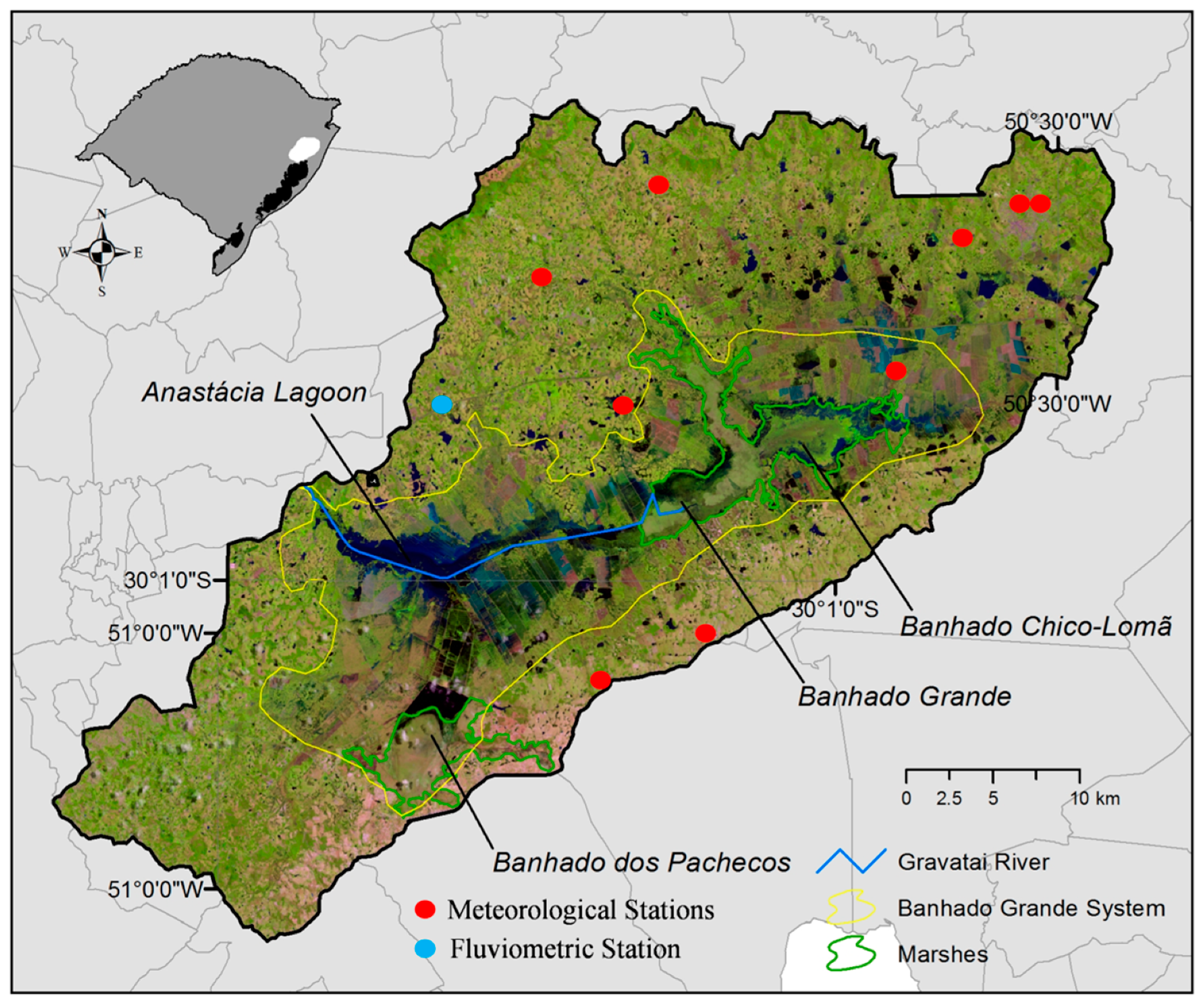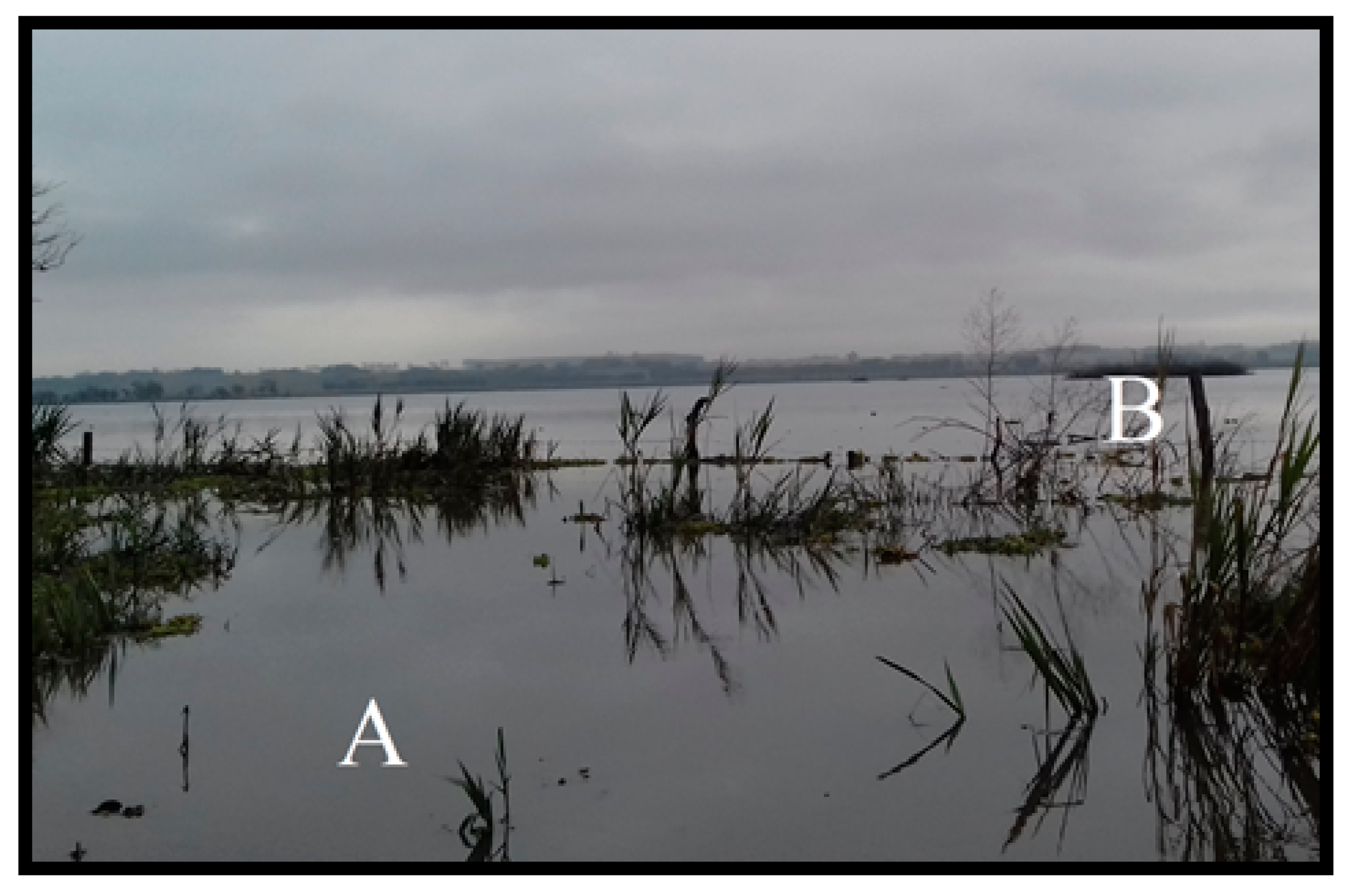A Remote Sensing-Based Method to Assess Water Level Fluctuations in Wetlands in Southern Brazil
Abstract
:1. Introduction
2. Materials and Methods
2.1. Study Area
2.2. Rainfall
2.3. Discharge and Evapotranspiration
2.4. Mapping of Apparent Water Level
3. Results
4. Discussion
5. Conclusions
Author Contributions
Funding
Conflicts of Interest
References
- Gownaris, N.J.; Rountos, K.J.; Kaufman, L.; Kolding, J.; Lwiza, K.M.M.; Pikitch, E.K. Water level fluctuations and the ecosystem functioning of lakes. J. Great Lakes Res. 2018, 44, 1154–1163. [Google Scholar] [CrossRef]
- Mondal, S.; Chakravarty, D.; Bandyopadhyay, J.; Maiti, K.K. Thematic analysis and mapping of surface water for sustainable mine planning. Sustain. Water Resour. Manag. 2018, 5, 743–753. [Google Scholar] [CrossRef]
- Varni, M.; Barranquero, R.S.; Zeme, S. Groundwater and surface water interactions in flat lands: The importance of ecological and flow regulation perspectives. Sustain. Water Resour. Manag. 2019, 5, 1791–1801. [Google Scholar] [CrossRef]
- Yin, D.; Wang, Y.; Xiang, Y.; Xu, Q.; Xie, Q.; Zhang, C.; Liu, J.; Wang, D. Production and migration of methylmercury in water-level-fluctuating zone of the Three Gorges Reservoir, China: Dual roles of flooding-tolerant perennial herb. J. Hazard Mater. 2020, 381, 120962. [Google Scholar] [CrossRef] [PubMed]
- Robinson, S.J.; Souter, N.J.; Bean, N.G.; Ross, J.V.; Thompson, R.M.; Bjornsson, K.T. Statistical description of wetland hydrological connectivity to the River Murray in South Australia under both natural and regulated conditions. J. Hydrol. 2015, 531, 929–939. [Google Scholar] [CrossRef]
- Liu, J.; Jiang, T.; Huang, R.; Wang, D.; Zhang, J.; Qian, S.; Yin, D.; Chen, H. A simulation study of inorganic sulfur cycling in the water level fluctuation zone of the Three Gorges Reservoir, China and the implications for mercury methylation. Chemosphere 2017, 166, 31–40. [Google Scholar] [CrossRef] [PubMed]
- Van Der Valk, A.G. Water-level fluctuations in North American prairie wetlands. Hydrobiologia 2005, 539, 171–188. [Google Scholar] [CrossRef]
- Grabas, G.P.; Rokitnicki-Wojcik, D. Characterizing daily water-level fluctuation intensity and water quality relationships with plant communities in Lake Ontario coastal wetlands. J. Great Lakes Res. 2015, 41, 136–144. [Google Scholar] [CrossRef]
- Bekele, A.A.; Pingale, S.M.; Hatiye, S.D.; Tilahun, A.K. Impact of climate change on surface water availability and crop water demand for the sub-watershed of Abbay Basin, Ethiopia. Sustain. Water Resour. Manag. 2019, 5, 1859–1875. [Google Scholar] [CrossRef]
- Grabas, G.P.; Fiorino, G.E.; Reinert, A. Vegetation species richness is associated with daily water-level fluctuations in Lake Ontario coastal wetlands. J. Great Lakes Res. 2019, 45, 805–810. [Google Scholar] [CrossRef]
- Shan, L.; Song, C.; Zhang, X.; Cagle, G.A.; Shi, F. Plant defence allocation patterns following an increasing water level gradient in a freshwater wetland. Ecol. Indic. 2019, 107, 105542. [Google Scholar] [CrossRef]
- Shah, J.A.; Pandit, A.K.; Shah, G.M. Dynamics of physico-chemical limnology of a shallow wetland in Kashmir Himalaya (India). Sustain. Water Resour. Manag. 2017, 3, 465–477. [Google Scholar] [CrossRef]
- Junk, W.J.; Piedade, M.T.F. Áreas Úmidas (AUs) Brasileiras: Avanços e Conquistas Recentes. Bol. ABLimno 2015, 41, 20–24. [Google Scholar]
- Zarista, S. Monitoramento da dinâmica de inundação no pantanal norte com uso de índices EVI e LSWI do MODIS. Master’s Thesis, Federal University of Mato Grosso, Cuiabá, Brazil, 2013. [Google Scholar]
- Guasselli, L.A.; Etchelar, C.B.; Belloli, T.F. Os impactos do cultivo de arroz irrigado sobre as áreas úmidas da Área de Proteção Ambiental do Banhado Grande do rio Gravataí—RS. In Proceedings of the XVI Brazilian Symposium on Remote Sensing, Foz do Iguaçu, Brazil, 13–18 April 2013. [Google Scholar]
- Gathman, J.P.; Albert, D.A.; Burton, T.M. Rapid Plant Community Response to a Water Level Peak in Northern Lake Huron Coastal Wetlands. J. Great Lakes Res. 2005, 31, 160–170. [Google Scholar] [CrossRef]
- Mauhs, J.; Marchioretto, M.S.; Budke, J.C. Riqueza e biomassa de macrófitas aquáticas em uma área úmida na planície costeira do Rio Grande do Sul, Brasil. Pesq. Bot. 2006, 57, 289–302. [Google Scholar]
- Morandeira, N.; Grings, F.; Facchinetti, C.; Kandus, P. Mapping Plant Functional Types in Floodplain Wetlands: An Analysis of C-Band Polarimetric SAR Data from RADARSAT-2. Remote Sens. 2016, 8, 174. [Google Scholar] [CrossRef] [Green Version]
- Mitsch, W.J. Wetland creation, restoration, and conservation: A Wetland Invitational at the Olentangy River Wetland Research Park. Ecol. Eng. 2005, 24, 243–251. [Google Scholar] [CrossRef]
- Finlayson, C.M. Freshwater Marshes and Swamps. In The Wetland Book; Finlayson, C.M., Milton, G.R., Prentice, C.R., Davidson, N.C., Eds.; Springer: Dordetch, The Netherlands, 2018; pp. 1–14. [Google Scholar]
- An, S.; Verhoeven, J. Wetlands: Ecosystem Services, Restoration and Wise Use, 1st ed.; Springer International Publishing: Basel, Switzerland, 2019. [Google Scholar]
- Maltchik, L.; Rolon, A.S.; Guadagnin, D.L.; Stenert, C. Wetlands of Rio Grande do Sul, Brazil: A classification with emphasis on plant communities. Acta Limnol. Bras. 2004, 16, 137–151. [Google Scholar]
- Carvalho, A.B.P.; Ozorio, C.P. Avaliação sobre os banhados do Rio Grande do Sul, Brasil. Rev. Ciec. Amb. 2007, 1, 83–95. [Google Scholar]
- Simioni, J.P.D.; Guasselli, L.A.; Ruiz, L.F.C.; Nascimento, V.F.; De Oliveira, G. Small inner marsh area delimitation using remote sensing spectral indexes and decision tree method in southern Brazil. Rev. Teledetección 2018, 55–66. [Google Scholar] [CrossRef] [Green Version]
- Junk, W.J.; Piedade, M.T.F.; Lourival, R.; Wittmann, F.; Kandus, P.; Lacerda, L.D.; Bozelli, R.L.; Esteves, F.A.; Nunes da Cunha, C.; Maltchik, L.; et al. Brazilian wetlands: Their definition, delineation, and classification for research, sustainable management, and protection. Aquat. Conserv. 2014, 24, 5–22. [Google Scholar] [CrossRef]
- Cunha, C.N.; Piedade, M.T.F.; Junk, W.J. Classificação e Delineamento das Áreas Úmidas Brasileiras e de seus Macrohabitats, 1st ed.; EdUFMT: Cuiabá, Brazil, 2015. [Google Scholar]
- Piedade, M.T.F.; Junk, W.J.; Souza Junior, P.T.; Cunha, C.N.; Schongart, J.; Wittmann, F.; Candotti, E.; Girard, P. As áreas úmidas no âmbito do Código Florestal brasileiro. In Código Florestal e a Ciência: O Que Nossos Legisladores Ainda Precisam Saber; Souza, G., Jucá, K., Wathely, M., Eds.; Comitê Brasil: Brasília, Brazil, 2015; pp. 9–17. [Google Scholar]
- Bittencourt, D.Z.; Guasselli, L.A. Dinâmica de Inundação do Banhado a partir do índice NDPI, Reserva Biológica de São Donato—RS. Rev. Dep. Geog. 2017, 33, 85–96. [Google Scholar] [CrossRef] [Green Version]
- Simioni, J.P.D.; Guasselli, L.A.; Etchelar, C.B. Connectivity among Wetlands of EPA of Banhado Grande, RS. Rev. Bras. Rec. Hidr. 2017, 22. [Google Scholar] [CrossRef] [Green Version]
- Accordi, I.A.; Hartz, S.M. Distribuição espacial e sazonal da avifauna em uma área úmida costeira do sul do Brasil. Rev. Bras. Ornit. 2006, 14, 117–135. [Google Scholar]
- Rossato, M.S. Os climas do Rio Grande do Sul: Variabilidade, tendências e tipologia. Master’s Thesis, Federal University of Rio Grande do Sul, Porto Alegre, Brazil, 2011. [Google Scholar]
- Villa Nova, N.A.; Ometto, J.P. Adaptação e simplificação do método de Penman às condições climáticas do Estado de São Paulo. In Proceedings of the Brazilian Symposium on Hidrology and Water Resources, São Paulo, Brazil, 15–19 November 1981. [Google Scholar]
- Fernandes, A.L.T.; Fraga Júnior, E.F.; Takay, B.Y. Avaliação do método Penman-Piche para a estimativa da evapotranspiração de referência em Uberaba, MG. Rev. Bras. Eng. Agr. Amb. 2011, 15, 270–276. [Google Scholar] [CrossRef] [Green Version]
- Makkink, G.F. Ekzameno de la formulo de Penman. Net. J. Agr. Sci. 1957, 5, 209–305. [Google Scholar]
- Liang, S. Narrowband to broadband conversions of land surface albedo I. Remote Sens. Environ. 2001, 76, 213–238. [Google Scholar] [CrossRef]
- McFeeters, S.K. The use of the Normalized Difference Water Index (NDWI) in the delineation of open water features. Int. J. Remote Sens. 1996, 17, 1425–1432. [Google Scholar] [CrossRef]
- Scuderi, C.M. Estimativa da taxa de evapotranspiração da macrófita aquática “Zizaniopsis Bonariensis”: Aplicação à simulação do nível de água do longo período do Banhado do Taim (RS). Master’s Thesis, Federal University of Rio Grande do Sul, Porto Alegre, Brazil, 2010. [Google Scholar]
- Junk, W.J.; Bailey, P.B.; Sparks, R.E. The Flood Pulse Concept in River-Floodplain Systems. In Proceedings of the International Large River Symposium, Honey Harbour, Canada, 14–21 September 1986. [Google Scholar]
- França, A.M.S.; Sano, E.E.; Sousa, A.O.; Fonseca, R.A. Sensoriamento Remoto na Identificação e Quantificação de Áreas Úmidas no Distrito Federal. In Proceedings of the IX Simpósio Nacional do Cerrado, Brasília, Brazil, 12–17 October 2008. [Google Scholar]
- Tassi, R. Gerenciamento hidroambiental de terras úmidas. Ph.D. Thesis, Federal University of Rio Grande do Sul, Porto Alegre, Brazil, 2008. [Google Scholar]
- District, W.M. Fluctuating Lake Levels in St. Johns River Water Management District. Available online: https://www.sjrwmd.com/education/lake-levels/ (accessed on 2 April 2020).
- Rubbo, M. Análise do potencial hidrogeológico do aqüífero cenozóico da bacia hidrográfica do rio Gravataí—RS. Master’s Thesis, Federal University of Rio Grande do Sul, Porto Alegre, Brazil, 2004. [Google Scholar]
- Gravathay, C. Plano de Recursos Hídricos da Bacia Hidrográfica do Rio Gravataí. Available online: http://www.comitegravatahy.com.br/index.php/plano-da-bacia (accessed on 2 April 2020).
- Collischonn, B.; Tucci, C. Relações Regionais entre Precipitação e Evapotranspiração Mensais. Rev. Bras. Rec. Hidr. 2014, 19, 205–214. [Google Scholar] [CrossRef]
- Brenner, V.C. Proposta metodológica para renaturalização de trecho retificado do Rio Gravataí -RS. Master’s Thesis, Federal University of Rio Grande do Sul, Porto Alegre, Brazil, 2016. [Google Scholar]
- Ward, J.V.; Stanford, J.A. Ecological connectivity in alluvial river ecosystems and its disruption by flow regulation. Regul. Rivers: Res. Manag. 1995, 11, 105–119. [Google Scholar] [CrossRef]




© 2020 by the authors. Licensee MDPI, Basel, Switzerland. This article is an open access article distributed under the terms and conditions of the Creative Commons Attribution (CC BY) license (http://creativecommons.org/licenses/by/4.0/).
Share and Cite
Simioni, J.P.D.; Guasselli, L.A.; de Oliveira, G.; Mataveli, G.A.V.; dos Santos, T.V. A Remote Sensing-Based Method to Assess Water Level Fluctuations in Wetlands in Southern Brazil. GeoHazards 2020, 1, 20-30. https://doi.org/10.3390/geohazards1010003
Simioni JPD, Guasselli LA, de Oliveira G, Mataveli GAV, dos Santos TV. A Remote Sensing-Based Method to Assess Water Level Fluctuations in Wetlands in Southern Brazil. GeoHazards. 2020; 1(1):20-30. https://doi.org/10.3390/geohazards1010003
Chicago/Turabian StyleSimioni, João P. D., Laurindo A. Guasselli, Gabriel de Oliveira, Guilherme A. V. Mataveli, and Thiago V. dos Santos. 2020. "A Remote Sensing-Based Method to Assess Water Level Fluctuations in Wetlands in Southern Brazil" GeoHazards 1, no. 1: 20-30. https://doi.org/10.3390/geohazards1010003






